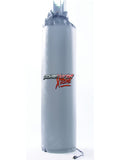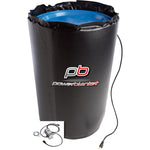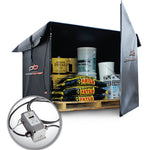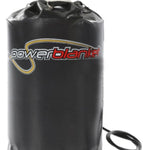You have no items in your shopping cart.
How to Weld in Cold Weather: Tips and Tricks
Article At-a-Glance
How Can You Successfully Weld in Cold Weather?
To successfully weld in cold weather, preheat the base metal, use low-hydrogen electrodes, and ensure your equipment is designed for low temperatures to prevent issues like rapid cooling, cracking, and inadequate penetration.
Key Takeaways
- Preheat and Prepare: Preheat the base metal using torches or induction heaters to prevent rapid cooling and cracking. Ensure electrodes are stored in a dry, heated location to avoid moisture absorption.
- Select Appropriate Equipment: Use welding machines with a high-duty cycle and stable arc to handle extended periods in cold conditions. Choose low-hydrogen electrodes and filler metals designed for low temperatures.
- Adjust Techniques: Slow down your travel speed to allow the weld pool to cool more gradually, reducing the risk of cracking and ensuring better penetration.
- Manage Environmental Conditions: Maintain the welding area above the minimum recommended temperature for the specific metal. If not feasible, focus on preheating and using tank heaters to ensure consistent propane supply.
- Prioritize Safety: Wear warm clothing to prevent hypothermia, ensure adequate ventilation, and use explosion-proof heaters for gas cylinders to maintain safety in hazardous environments.
From towering bridges to intricate pipelines, welding plays a crucial role in building the infrastructure we rely on. While the construction season might slow down in some regions, many industries continue their welding operations year-round. This article explores the challenges of cold weather welding and offers solutions to ensure strong, reliable welds even in the harshest conditions.

$1,460.00 USD
9" x 40" K Size Explosion-Proof Gas Cylinder Heater C1D2T4 (120V)
For safer welding operations in winter, consider using explosion-proof tank heaters. These heaters keep your gas tanks running properly, ensuring safety and efficiency in cold environments.
What are the Challenges of Welding in Cold Weather?
Low temperatures pose several significant challenges for welding steel. The most critical concern is cold cracking. As metal cools, it contracts. When welding in cold weather, the rapid temperature drop can cause the weld joint to contract too quickly, creating microscopic cracks in the metal. These cracks can compromise the joint's integrity and lead to premature failure.
Additionally, cold temperatures can affect arc stability, making it harder to maintain a consistent weld pool. Furthermore, there's a minimum temperature for effective welding with different materials. Exceeding this limit can lead to issues like incomplete fusion and porosity in the weld.
Cold Weather and Its Impact on Materials
Metals become less ductile and more brittle when cold. Ductility refers to a material's ability to deform under stress without breaking. Steel, for example, becomes less forgiving and more prone to cracking in cold weather. The science behind this phenomenon lies in the rearrangement of atoms within the metal's crystalline structure at lower temperatures. This rearrangement limits the movement of these atoms, making the metal stiffer and more susceptible to cracking under the stress of welding.

What is the Best Cold Welding Technique?
Cold welding, also known as pressure welding, is different from traditional arc welding methods. It utilizes extreme pressure to forge a permanent joint between two clean metal surfaces without melting them. Cold welding is good to use in specific situations like electrical connections or repairs on existing structures where traditional welding methods might be impractical or risk of heat damage. However, this technique is not a substitute for arc welding in most construction and fabrication applications.
Stick Welding in Cold Conditions
Stick welding, also known as arc welding with consumable electrodes, is another choice for cold weather welding due to its versatility and ability to produce deep welds. Here are some tips for optimizing stick welding in low temperatures:
- Use low-hydrogen electrodes, designed to minimize the formation of hydrogen in the weld, which can contribute to cracking.
- Store electrodes in a dry, heated location to prevent moisture absorption. Moisture can lead to porosity in the weld.
Tips for Successful Cold Weather Welding
Conquering the challenges of cold weather welding requires a multi-pronged approach. Here are some key tips to ensure successful welds even in frigid temperatures:
- Material Preparation: Preheat the base metal to a recommended temperature before welding. This can be achieved using torches, induction heaters, or weld blankets.
- Technique Adjustments: Slow down your travel speed to allow the weld pool to cool slower and reduce the risk of cracking.
- Welding Supplies: Use electrodes or filler metals specifically designed for cold weather welding. These consumables often have a lower melting point and improved low-temperature toughness.
Selecting the Right Welding Machine and Supplies
Choosing the right equipment makes a world of difference in cold weather conditions. Look for welding machines with features such as:
- High-duty cycle: This ensures the machine can handle extended welding periods without overheating, crucial in cold environments where operators might need to wear bulky clothing.
- Stable arc: A stable arc minimizes spatter and improves weld consistency, especially important when working with less forgiving materials in cold weather.
- Amperage range: Select a machine with sufficient amperage output to accommodate the chosen electrode size and welding thickness.
Do I Need a Propane Heater?
Cold weather welding means more than knowing what method is best. Making sure you have enough propane to weld with is also essential, as low temperatures can impact how much usable propane is available in the tank.
How long does a propane tank last? With help from a tank heater, propane tanks can go from lasting mere weeks to several months in the winter. Equipment needed for cold weather welding includes welding-specific tank heaters, such as the C1D2T4 K-size tank heater.

Preventing Cold Cracking and Other Issues
The primary strategy for preventing cold cracking is to maintain the right ambient temperature. Ideally, the welding area should be above the minimum recommended temperature for the specific base metal and welding process. If maintaining a warm environment isn't feasible, preheating the base metal becomes even more crucial.
Industry-Specific Considerations for Cold Weather Welding
Different industries approach cold weather welding with specific considerations:
- Construction: Following industry standards and welding codes for cold weather operations is essential.
- Shipbuilding: Maintaining a controlled environment within the shipyard becomes crucial for large-scale welding projects during winter months.
- Oil and Gas: Welding procedures for pipelines and pressure vessels often require stricter adherence to preheating protocols.
Safety Measures in Cold Weather Welding
Safety remains a top priority in cold weather welding. Key safety considerations include:
- Warm clothing for the welder to prevent hypothermia.
- Adequate ventilation to remove welding fumes.
- Fire safety, including regular inspection of cables and removal of flammable materials from the workspace.
Additionally, make sure any heating equipment is rated for hazardous environments. Gas cylinder heaters for hazardous locations are key for workplace safety during the winter.
Conclusion
Welding in cold weather isn’t easy, but with the right knowledge and equipment, you can still get the job done. Effective cold weather welding is about creating a controlled environment – for both the materials and the welder. By adopting these strategies and adapting them to your specific needs, you can ensure that winter doesn't put a freeze on your welding projects.













